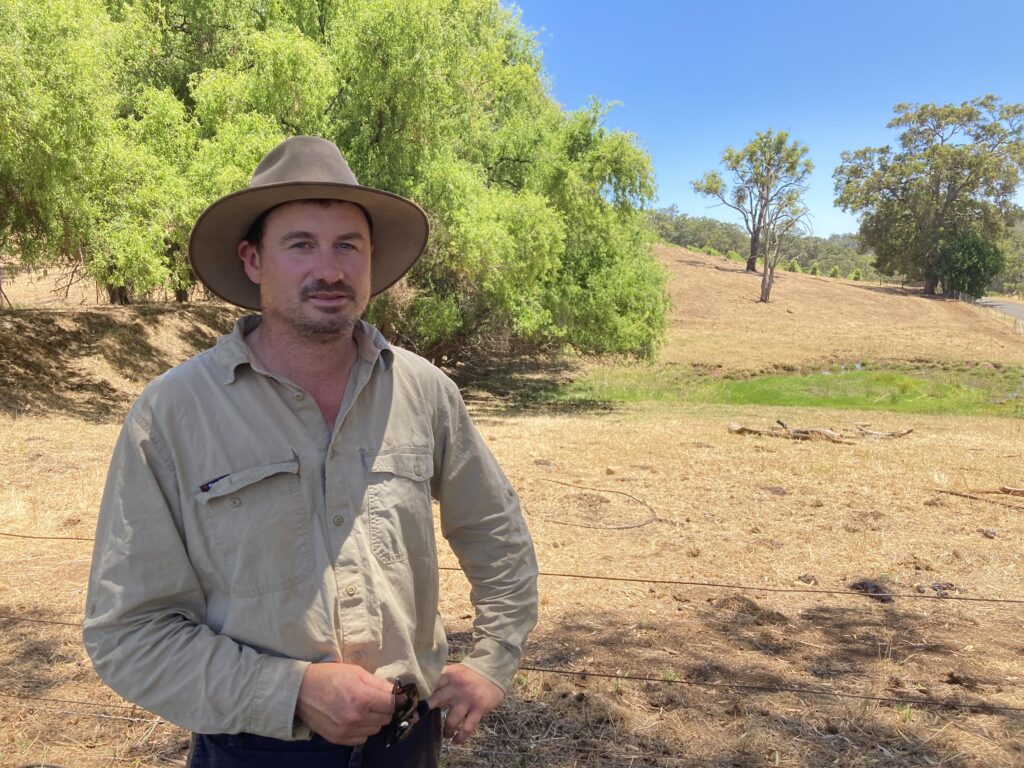Shocking season finish highlights risk of complacency
Take Home Messages:
- Don’t be complacent. Always be prepared for dry seasons.
- Make your decisions early.
- Be awake to the season. If you’re not in tune with what’s going on out there you can get caught.
- Measure how much water your vines are getting and consider updating inefficient systems.
Ryan Gibbs runs beef cattle and a vineyard on 486 hectares in the Ferguson Valley. We spoke to him in early December 2023 to learn how he’s managed the driest finish since 2010.
Ryan’s family has farmed in the Ferguson Valley for over 150 years. After going away to study Viticulture and Winemaking, Ryan’s second year back on the farm was in 2010, one of the driest on record. It’s a year he’s never forgotten and ensures that he doesn’t get complacent after a run of good years. However, he admits 2023 still got the better of him.

“It’s been an absolute shocker,” he said.
“I normally get about 900 hay rolls but got between 400 and 450 this year.
“I also have a lease block in Dardanup where last year I got 300 silage rolls. This year we got 125.
“That was a big letdown when I thought I’d done everything I could to spread risk and diversify.
“I could see it coming (the dry season), so I went earlier with my spring fertilisers, I shut paddocks earlier, and I still got caught. But I’ve got hay in the shed and I’ve got leftover silage from last year, which was done by design, so we’ll get through.”
Since 2010, Ryan has been more proactive with his decisions.
“I had to buy hay for the first time in my life (in 2023),” he said.
“I just went straight out and found it, I don’t care how much it costs because it’s going to cost more if I need it in May, and you won’t be able to find it then.
“If it turns out that we get an early break and I don’t need it, then it will just stay in the shed, but I’ve got it up my sleeve.
“I’ve also sold more cattle than I normally would, and I’ve sold them earlier. Extra weaners.
“Hang the price! Get rid of them because if you don’t make the decision early, you’re going to struggle at the other end.”
When Ryan took over the farm he started calving earlier in the year, but he soon started to delay calving to save feed. In 2024 he will start calving on March 20. This reflects a change in the end use for his calves – instead of aiming to finish calves to abattoir spec he now concentrates on producing feeder cattle.
“I know some guys who will be managing cows with calve at foot from January,” he said.
“In a dry year that’s going to be challenging, and to achieve what at the other end? That three months of feeding isn’t going to achieve a lot more for the operation I’m running.
“I sent calves to sale today (December 6) and they’re hitting specifications, so why would I want to calve them a week earlier and stick all the feed and time into them to reach the same spec?” This is what works for my business – other producers will tailor their approach to what works best for them.
However, Ryan won’t calve much later.
“Late calvers put on too much condition and you have calving issues,” he said.
“Tightening up the range is a better aim. So instead of three and a half cycles, bring it back to two cycles. I think that can be beneficial to your end product and your program and means you can start later again because all the calves will be on the ground in eight weeks.
“I’ve also got to work around the wine industry, so I don’t want cows calving while I’m picking grapes.”
In terms of improvements in the vineyard to manage dry years, Ryan’s seen a big gain from renewing his irrigation system.
“I’ve replaced all my driplines in the last 2-3 years,” he said.
“I knew they weren’t working properly. We’ve got a bit of iron in our water that degrades the drippers over time, so we were wasting water. Times were good with beef, so I thought I’d reinvest into new driplines.
“It’s amazing how much water it saves. It’s a no-brainer.”
Ryan uses pressure-compensating driplines, which deliver the same amount of water to vines at the top and bottom of hills.
“The old-style emitters that you poke in are hopeless. I’d be tearing my hair out in a year like this if I hadn’t replaced all my irrigation,” he said.
Ryan emphasises the value of measuring how much water you are using.
“Anyone that’s irrigating should be measuring how much your drippers are putting out.
“Put a bucket under it to see if you’re matching output with the recommended litres per vine.”
This case study is supported by the SW WA Drought Hub, through funding from the Australian Government’s Future Drought Fund.
To read more Drought Adaptation Case Studies, visit this page of our website.
